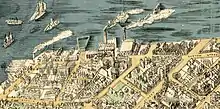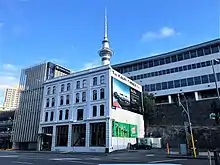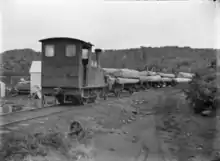Kauri Timber Company
The Kauri Timber Company, Limited, (KTC) Auckland was from 1888 to 1944 a large logging and sawmilling company in New Zealand.
%252C_after_its_takeover_by_the_Kauri_Timber_Company_in_1888%252C_looking_east.jpg.webp)

KTC was formed in 1888, with a capital of £1,250,000, paid up to £750,000, and its operations were of a very comprehensive nature. Besides KTC's headquarters in Melbourne and a branch in Sydney, there were sixteen branches in New Zealand, where the timber was milled.[1] The forests owned by KTC made it the fifth-largest landholding company in the country, which removed much of North Island’s native forest, initially kauri and later kahikatea,[2][3] assuring steady supplies for its mills for many years. Between 300 and 400 men were engaged in the Auckland mill and factory, and throughout the whole of the company's operations in mills, stores, and forests, some 5000 or 6000 people were employed. In its extensive export trade the company employed a large fleet of vessels, and was represented in the markets of Great Britain, Cape Colony, Australia and the South Sea Islands.[1] The operations of the company expanded even to Vanikoro in the Solomon Islands, where it merged in 1925 with San Cristoval Estates Ltd. to form the Vanikoro Kauri Timber Company.[4]
The Auckland mill burnt down in 1942[5] and a new yard opened in Penrose in 1944. The 4-storey office at 104 Fanshawe St, which had been opened in 1882 by KTC's predecessor, Auckland Timber Co, and is now a Category 1 listed building, was sold to Austral Super Paint Ltd[3] and a single storey office opened in the new yard.[6]
KTC was hit by 'the Menzies bloody Credit Squeeze' mini-budget in 1961 and invited Fletcher Holdings to buy KTC's New Zealand assets. First the Christchurch plywood factory, Butler Bros, Stuart & Chapman and Ellis & Burnand were sold on 5 June 1961 for NZ£750,000 (A£930,000), though they were said to be worth well in excess of £1 million. KTC's other New Zealand assets were sold to Fletcher for £1.6 million later in the year. KTC's customers and senior staff were not happy with the take over, causing profitability to drop. [7] They were merged into Fletcher Challenge in 1981.[8]


Kauri Timber Company was sold to East Asiatic Company in 1971.[9] Chatlee mill at Smithton was upgraded, 'home centres' were opened in Adelaide and Melbourne and Devonport and Deloraine sawmills were sold to J. & T. Gunn. Kauri Holdings Ltd was listed on the Victoria Stock Exchange[10] in 1987.[11]
_-(Catalogue._Front_cover._ca_1906)._(21490058032).jpg.webp) Premises at Custom Street West, Auckland, with the Joinery and Box Departments at the left, and the head office at the right, joined by an overhead walkway, ca 1906.
Premises at Custom Street West, Auckland, with the Joinery and Box Departments at the left, and the head office at the right, joined by an overhead walkway, ca 1906._-Balustrades_(and)_balusters._(Catalogue_page._ca_1906)._(21698826291).jpg.webp) Balustrades and balusters, ca. 1906
Balustrades and balusters, ca. 1906_-Gates._(Catalogue_page._ca_1906)._(21473107010).jpg.webp) Gates, ca. 1906
Gates, ca. 1906_-Trusses%252C_modillions%252C_bay_window_angle_brackets._(Catalogue_page._ca_1906)._(21510406691).jpg.webp) Trusses, ca. 1906
Trusses, ca. 1906
External links
References
- Kauri Timber Company. In: The Cyclopedia of New Zealand (Auckland Provincial District). The Cyclopedia Company, Limited, 1902, Christchurch.
- "ATC Building, 104 Fanshawe St, Auckland". www.heritage.org.nz. Retrieved 2019-06-16.
- "Auckland Timber Company Building (Former)". www.heritage.org.nz. Retrieved 2019-04-21.
- The University of Melbourne Archives, Reference Number: 1966.0012.
- "KAURI CO. FIRE. AUCKLAND STAR". paperspast.natlib.govt.nz. 23 April 1942. Retrieved 2019-08-11.
- "Kauri Timber Company Ltd office, Auckland - 9097P/1". www.fletcherarchives.co.nz. Retrieved 2019-04-21.
- Goldsmith, Paul (2009). Fletchers: A Centennial History of Fletcher Building. David Ling Publishing. pp. 170–172. ISBN 978 1 877378 35 5.
- Carter, Graeme (Feb 2019). "The enterprising Butler brothers". NZ Railway Observer: 245–253.
- "Food Ingredients Specialist – Kauri NZ » About Us » History". www.kaurifood.com. Retrieved 2019-04-21.
- Michael Roche, John Dargavel and Jenny Mills. "TRACKING THE KTC FROM KAURI TO KARRI TO CHATLEE" (PDF). p. 203.
- "COMPANIES (ACQUISITION OF SHARES) (VICTORIA) CODE Section 58 DECLARATION". Commonwealth of Australia Gazette. General (National : 1977 - 1987). 1987-02-03. p. 354. Retrieved 2019-04-21.